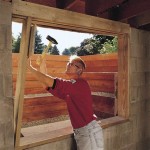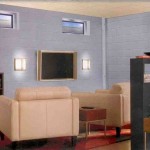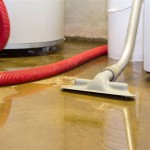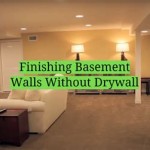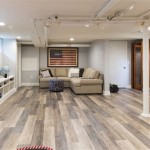How To Soundproof A Ceiling In A Basement
Soundproofing a basement ceiling offers numerous benefits, from creating a more peaceful living space upstairs to enabling the development of a dedicated entertainment area downstairs. Effectively reducing noise transfer involves understanding the principles of sound transmission and applying appropriate soundproofing techniques.
Sound travels through vibrations. When sound waves encounter a structure, they cause it to vibrate. These vibrations then transmit the sound to the other side. Soundproofing aims to disrupt this process, either by absorbing the sound waves or by decoupling the ceiling structure to minimize vibration transfer.
One primary method for soundproofing a basement ceiling is the addition of drywall. Standard drywall provides some sound dampening, but specialized sound-dampening drywall, often referred to as "QuietRock" or similar brand names, offers significantly better performance. These specialized boards are denser and contain viscoelastic polymers that effectively absorb sound energy.
Installing the drywall with resilient channels further enhances soundproofing. These metal channels are attached to the ceiling joists and create an air gap between the joists and the drywall. This air gap decouples the drywall from the joists, reducing the transmission of vibrations. Green Glue, a specialized damping compound, can be applied between the resilient channels and the drywall to further dissipate sound energy.
Mineral wool insulation plays a crucial role in absorbing sound waves within the ceiling cavity. Densely packed mineral wool, with a high Noise Reduction Coefficient (NRC) rating, effectively absorbs a broad range of frequencies. Ensuring the ceiling cavity is completely filled with insulation maximizes sound absorption.
Addressing flanking noise paths is essential for comprehensive soundproofing. Flanking noise refers to sound that bypasses the primary ceiling structure by traveling through adjacent walls, ductwork, or other structural elements. Sealing any gaps or cracks around the perimeter of the ceiling with acoustic sealant prevents flanking noise.
Drywall is typically installed in multiple layers for improved soundproofing. Each layer adds mass and further disrupts the transmission of sound vibrations. Staggering the seams between drywall layers prevents sound leakage through these joints.
Ceiling fixtures, such as recessed lighting, can compromise soundproofing efforts. These fixtures create holes in the ceiling, allowing sound to pass through. Using airtight, soundproof recessed lighting housings helps mitigate this issue.
The type of ceiling joists also influences sound transmission. Solid wood joists transmit sound more readily than engineered I-joists. While replacing existing joists is often impractical, understanding their role in sound transmission informs other soundproofing choices.
For suspended ceilings, specialized acoustic tiles can provide effective sound absorption. These tiles are designed to absorb a wide range of frequencies and are available in various textures and styles to suit different aesthetics.
Impact noise, such as footsteps or dropped objects, presents a unique challenge. Decoupling the floor above the basement ceiling is the most effective way to address impact noise. This can involve installing a floating floor system or using specialized underlayment designed to absorb impact vibrations.
The choice of soundproofing materials and techniques depends on the specific needs and budget of the project. Consulting with a qualified acoustical consultant can provide tailored recommendations based on the existing construction and desired level of soundproofing.
Careful planning and precise execution are essential for successful soundproofing. Properly sealing all gaps and cracks, ensuring complete insulation coverage, and correctly installing sound-dampening materials contribute significantly to the overall effectiveness of the soundproofing system.
Regularly inspecting and maintaining the soundproofing system helps ensure its long-term performance. Addressing any gaps or cracks that develop over time, and replacing damaged or worn materials, maintains the integrity of the soundproofing system.
Building codes and regulations may apply to soundproofing projects. Checking local building codes and obtaining any necessary permits before starting work ensures compliance with regulations and avoids potential issues.
The effectiveness of soundproofing is measured in Sound Transmission Class (STC) ratings. Higher STC ratings indicate better soundproofing performance. Understanding STC ratings helps compare different soundproofing materials and systems.
Soundproofing a basement ceiling is a multi-faceted process that requires careful consideration of various factors. By understanding the principles of sound transmission and applying appropriate soundproofing techniques, one can create a more comfortable and acoustically pleasing living environment.

Soundproofing Ceilings How To Soundproof A Ceiling

How To Soundproof A Basement Ceiling

Nova Basement Remodeling Soundproofing In

Soundproofing A Home Workshop Technical Details Two Teaching Videos

Soundproofing A Ceiling Unfinished Basement Ideas Cheap Renovations

Bungled Basement Soundproofing The Expert

How To Soundproof Your Basement Ceiling Restoration By L B

Botched Duplex Soundproofing The Expert

Strategies For Soundproofing Ceilings Sound Acoustic Solutions

7 Ways To Soundproof A Ceiling That Really Work Sound Proofing Insulation
See Also

